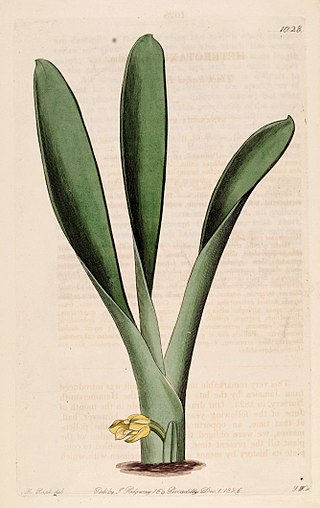
Maxillaria, abbreviated as Max in the horticultural trade, is a large genus of orchids. This is a diverse genus, with very different morphological forms. Their characteristics can vary widely. They are commonly called spider orchids, flame orchids or tiger orchids. Their scientific name is derived from the Latin word maxilla, meaning jawbone, reflecting on the column and the base of the lip of some species, that may evoke a protruding jaw.

Maxillaria amplifoliata is a member of the family Orchidaceae. It was previously in the genus Cryptocentrum, in which it was the largest species. Cryptocentrum is now synonymous with Maxillaria.

The Field Elm cultivar Ulmus minor 'Umbraculifera Gracilis' was obtained as a sport of 'Umbraculifera' by the Späth nursery of Berlin c.1897. It was marketed by the Späth nursery in the early 20th century, and by the Hesse Nursery of Weener, Germany, in the 1930s.
Trigonidium, abbreviated as Trgdm in horticultural trade, was a formerly accepted genus of orchids comprising roughly twenty species found from Mexico to Brazil. As of 2023, it was considered a synonym of Maxillaria.

Maxillaria desvauxiana is a species of orchid native to tropical South America. It is known from Bolivia, Brazil, Colombia, Ecuador, French Guiana, Guyana, Peru, Suriname and Venezuela.
Maxillaria donaldeedodii, synonym Ornithidium donaldeedodii, is a species of orchid native to Haiti. It was "discovered" in April 2010 when DNA analysis showed that a wrongly labeled orchid at the University of California Botanical Garden in Berkeley, California, was actually a distinct new species. The "new" orchid, which had been mislabeled as Maxillaria croceorubens since the 1990s, was named after orchidologist Donald D. Dod (1912–2008), who collected the specimen in the 1980s in Haiti. The new orchid was officially described in Lankesteriana, an international journal on orchidology, by authors James Ackerman of the University of Puerto Rico and W. Mark Whitten of the Florida Museum of Natural History, as Ornithidium donaldeedodii. It was transferred to Maxillaria in 2011.
Aletes humilis is a species of flowering plant in the carrot family known by the common names Colorado aletes and Larimer aletes. It is native to Colorado in the United States; it is also known from Wyoming, but there are no recent collections there.

Maxillaria schunkeana is a species of orchid. The colors of its flower are very close to black, but it is actually a very dark purple-red, giving the impression of a black flower.

Maxillaria picta is a species of plant in the orchid family native to Brazil, Paraguay and Argentina.

Urtica gracilis, commonly known as the slender nettle, tall nettle, or American stinging nettle, is a perennial plant plant without woody stems that is well known for the unpleasant stinging hairs on its leaves and stems. It is native to much of the North America from Guatemala northwards and temperate areas of South America. It is easily confused with the visually very similar Eurasian species Urtica dioica and is still listed in some resources as a subspecies of this plant. However, genetic analysis and experiments show that they are genetically distinct.

Maxillariinae is an orchid subtribe in the tribe Cymbidieae. It was formerly treated as the tribe Maxillarieae, and divided into a number of subtribes.

Tulipa humilis is a species of flowering plant in the lily family, found in Syria, Lebanon, Israel, Turkey, Iran, and the North Caucasus region of Russia. The flowers are pink with yellow centers. Its preferred habitat are rocky mountain slopes. It is known by several other names in horticulture.
Jovetia is a monotypic genus of plants in the family Rubiaceae. It contains only one currently accepted species, Jovetia humilis, endemic to Madagascar.

Maxillaria crassifolia, synonyms including Heterotaxis sessilis, is an epiphytic orchid widespread across the West Indies, Central America, southern Mexico, Florida and northern South America. Hidden orchid is a common name.

Maxillaria parviflora, the purple tiger orchid, is a species of epiphytic orchid native to Florida, the West Indies and through Latin America from Mexico to Bolivia.
Maxillaria petiolaris, synonym Hylaeorchis petiolaris, is a species of epiphytic orchids native to northwestern South America. When placed in the genus Hylaeorchis, it was the only species.

Lotus herbaceus is a herbaceous perennial plant belonging to the genus Lotus of the family Fabaceae. The species includes the plants formerly called Dorycnium herbaceum and Dorycnium jordanii. The flowering period extends from May through July.

Trachycarpeae is a tribe of palms in subfamily Coryphoideae of the plant family Arecaceae. It has the widest distribution of any tribe in Coryphoideae and is found on all continents, though the greatest concentration of species is in Southeast Asia. Trachycarpeae includes palms from both tropical and subtropical zones; the northernmost naturally-occurring palm is a member of this tribe. Several genera can be found in cultivation in temperate areas, for example species of Trachycarpus, Chamaerops, Rhapidophyllum and Washingtonia.

Trimezia humilis is a species of bulbous plant in the family Iridaceae. Native to Venezuela and parts of Brazil. The species was originally named Cypella humilis by Friedrich Wilhelm Klatt in 1862. Pierfelice Ravenna then moved the species into the genus Trimezia in 1977.

Chaetogastra gracilis is a species of flowering plant in the family Melastomataceae. It is native to much of South America, from Venezuela in the north to northeast Argentina in the south. It was first described in 1823 by Aimé Bonpland as Rhexia gracilis. Its synonyms include Tibouchina gracilis.















